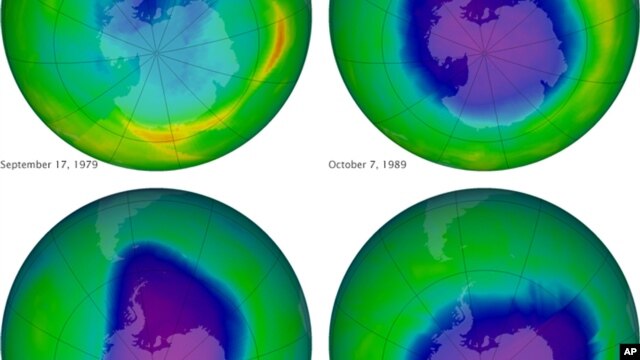Report: Ozone Layer on Road to Recovery

Geneva- The World Meteorological Organization reports the earth’s protective ozone layer is on track to recovery by the middle of the century. The agency says the so-called Montreal Protocol, which calls for the phase out of ozone-depleting substances is working.
The World Meteorological Organization (WMO) calls the 1987 Montreal Protocol a great success. This news comes as a welcome antidote to the recent bleak assessment by the same agency that the concentration of greenhouse gas levels in the atmosphere reached record levels last year.
WMO Senior Scientific Officer Geir Braathen says a lot has changed for the better since the agency issued its last scientific assessment of ozone depletion four years ago.
“Now, for the first time in this report, we say that we see indications of a small increase in total ozone. So that means that recovery of the ozone layer in terms of total ozone has just started. If you go more specifically at the higher level, about 40 kilometers in the stratosphere high above the ground, there one sees a clear increase in ozone in recent years," said Braathen.
Braathen says this is a sign that the amount of ozone depleting gases is going down and the ozone is on the way up again. The stratospheric ozone layer is a fragile shield of gas that protects the Earth from harmful ultraviolet rays of the sun.
The U.N. Environment Program says the Montreal Protocol will have prevented two million cases of skin cancer annually by 2030, averted damage to human eyes and immune systems, and protected wildlife and agriculture.
The treaty calls for the phase out of ozone depleting substances, such as chlorofluorocarbons and halons, which were once used in products such as refrigerators, spray cans, insulation foam and fire suppression.
The report finds the phase-out of ozone depleting substances has had a positive spin-off for the global climate because many of these substances also are potent greenhouse gases. But the report cautions that certain substitutes are themselves potent greenhouse gases that potentially could undermine these gains.
Braathen says new replacement compounds called hydrofluorocarbons do not harm the ozone layer. But, many are potent greenhouse gases.
“The emission of HFC’s [hydrofluorocarbons] is currently increasing at the rate of about 7 percent per year. So it is coming up quite quickly. Currently, they have an almost negligible effect on the climate, but if they continue to grow like this also in the future over the coming decades, they will, in the future, contribute significantly to global warming," he said.
But the good news, says Braathen, is compounds are available that have much lower greenhouse warming effects. He says the ozone layer is expected to recover to 1980 benchmark levels - that was before significant ozone depletion - over most of the globe by 2050 if there is full compliance with the Montreal Protocol.
WMO calls international action on the ozone layer a major environment success story. It is urging the same kind of unity to tackle the even greater challenge of climate change.
|





